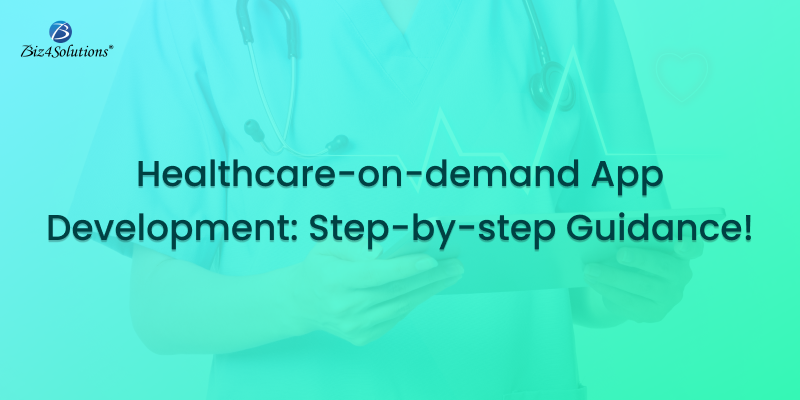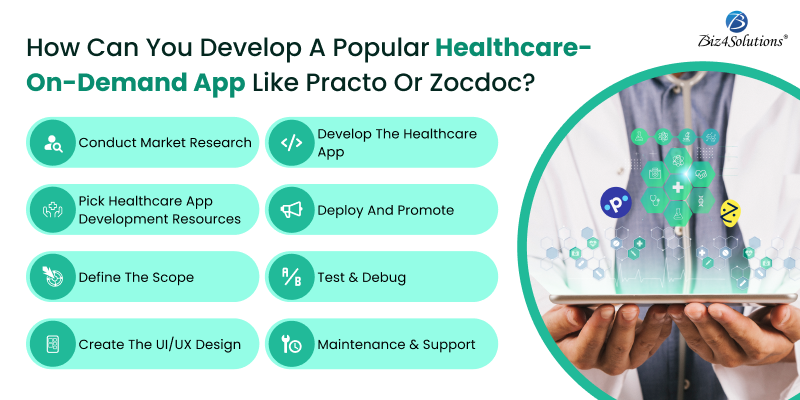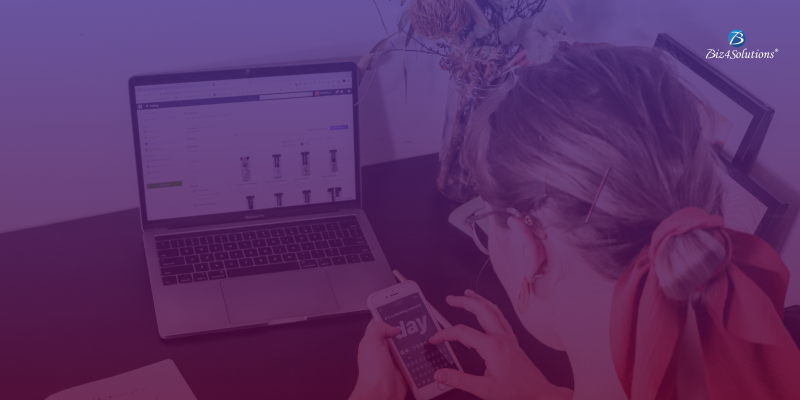How can you develop a Popular Healthcare-on-demand app like Practo or Zocdoc?


The adoption rate of on-demand healthcare apps is skyrocketing. Yet, some healthcare-on-demand apps gain unprecedented popularity while some applications fail to impress! What can be the reason? Well, issues like poor usability, erratic data, inconsistent UX, and the lack of security protocols lead to the failure of certain healthcare apps.
Healthcare app development is a complex process and app creators need to follow the right approach, and best practices and consider several other factors for crafting an impeccable solution. This post guides you through the right process and approaches to developing a popular healthcare application like Practo or Zocdoc. We will discuss the reasons why these apps have garnered unprecedented popularity as compared to other apps. A quick read will provide you with an idea of how to go about the process of healthcare app development and you’ll know which strategies to adopt for making your app stand out from similar apps existing in the market.
What are the Healthcare industry pain areas an on-demand Healthcare App will resolve?
Accessibility:
Certain patients find it challenging to access medical facilities in person owing to constraints such as mobility issues, residing in remote locations, or super-busy schedules. An on-demand healthcare app will make their lives easier by simplifying the process of finding the most suitable healthcare practitioner or provider, appointment scheduling, and availing of online consolations for minor medical issues or follow-ups. With an on-demand healthcare app, patients can access healthcare services regardless of their location or the time.
Improved Patient Experience
An on-demand healthcare app enables providers to offer an elevated patient experience with lesser wait times, better access to healthcare facilities, improved coordination with doctors, etc. Patients can enjoy the convenience of online appointment scheduling without having to bear the hassles of paying a visit or making a phone call to the healthcare facility. Providers can also improve patient engagement by sending patients follow-up doctor visit reminders via notifications, medical record reviews, etc.
Administrative Benefits
A doctor on-demand app helps medical providers to digitize their services and automate routine operational tasks. As such, healthcare digitalization boosts the provider’s operational efficiency, minimizes errors, reduces administrative workload, saves time, and improves patients’ healthcare data management. Moreover, patients can easily access their medical records including lab & imaging results, treatment history, medication details, appointment history, etc.
The Offerings of Popular on-demand Healthcare Apps like Zocdoc and Practo
Take a look at how popular healthcare apps like Practo and Zocdoc have succeeded to gain universal acceptance amongst their target audiences. Both these applications aim to resolve an existing issue, offer a combination of basic and advanced features, and include some USPs. Parcto and Zocdoc have come up with a sound monetization strategy as well.
Practo
Practo offers its users a combination of free and paid features. Practo users can search for a specialist doctor based on their specific requirements. The doctors’ specializations, years of experience, reviews & ratings, etc. are displayed. Once the doctor consultation takes place, the medical reports are uploaded in the app for future reference of the patients as well as the doctors. Practo also provides USPs such as secure clinical records storage, online medicine ordering & doorstep delivery, and a directory of healthcare blogs.
Monetization Strategy:
Practo’s revenue generation strategy includes charges collected from doctors and patients and the sale of ad spaces. Doctors, hospitals, or clinics opting for the “Practo Reach” (“premium listing”) feature are charged for appearing at the top of the search results. It also offers a paid Cloud-based software for doctors called “Practo Ray” for managing the healthcare data of patients. Paid features for patients include medicine delivery services and a real-time video consultation facility.
Zocdoc
Zocdoc focuses on reducing the wait times for patients. It offers online appointment booking services to patients using the advanced search feature. A patient-centric search feature has been specifically created for individuals who are not well acquainted with the healthcare jargon. Patients can also check whether insurance coverage is available for their specific use case. An AI-powered feature is there for understanding and verifying patients’ insurance requirements. Users can utilize the map feature for locating doctors as well as insurance networks.
Monetization Strategy:
Doctors are charged for registering themselves on the platform and patients are charged an appointment booking fee. Doctors can also avail of the paid service of “featured results” which improves their chances of getting discovered by patients.
On-demand Healthcare App Development: Steps to Follow

Now, you’ve gained an idea of how to shape your healthcare app business model for maximizing customer acceptance and generating a continuous revenue stream. Here’s step-by-step guidance to execute your idea into a fully-functional application.
Conduct Market Research
Conduct market research to figure out the target users’ pain areas, user preferences, and ongoing trends in the healthcare app development arena. Analyze these requirements to create an idea that will prove beneficial to your end customer and fulfill your business objectives at the same time.
It’s important to focus on resolving a consumer pain area to convince your target audience to download your app. Also, check out similar apps existing in the market to understand why some apps have gained popularity and why certain applications have failed to make a mark.
Pick Healthcare app development resources
Now, it’s time to pick your resources depending on the healthcare app development use case. You can either go for in-house resources or partner with an experienced healthcare app development company for this purpose. Hiring independent resources doesn’t seem to be a good idea for creating a healthcare app. Ensure that the healthcare app development service you’ve selected adopts an agile methodology for product development.
Define the Scope
Define the specific use case and finalize the features of the on-demand healthcare app. You need to select the operating system or systems your app will target. To maximize customer outreach, targeting all three platforms – Android, iOS, and the Web – will prove beneficial.
Some of the key functionalities to include in a healthcare app are:
User Module
- Profiles for Patients & Practitioners
- User authorization and authentication
- AI-empowered symptom checker
- Appointment Scheduling and management modules
- Clinic or doctor search with advanced filters
- EMR (Electronic Medical Records) for saving and managing patients’ healthcare data, prescriptions, test results, etc.
- ePrescriptions and prescription management modules
- Wearable devices integration
- Doctor-patient communication via chat or messaging
- Virtual Doctor consultation modules like video or audio consultation, messaging, etc.
- Reviews and ratings for doctors and medical facilities
Admin Module
- Dashboard: Admins can get an overview of all the app users – patients and practitioners
- Management Modules for Doctors and Patients
- Payment management
- Push Notifications
Create the UI/UX Design
While designing the UI/UX, you need to focus on user engagement and satisfaction. Develop a simple, user-friendly, intuitive, and clutter-free UI that is effortlessly accessible and then create the app’s flow. Also, make sure that your app’s design caters to users with disabilities like visual impairment. The app’s content should be well organized. There must be consistency in the app’s design elements like imagery, font, color, etc. so that users get the experience of a unified whole. Your app should be effortlessly navigable so that users can instantly find the information they are looking for.
Develop the Healthcare App
Now, comes one of the most crucial phases – healthcare app development.
Database Designing: Develop the entity-relationship models for different features and design the database schema using optimal normal forms. Pick a database management system and thereafter create tables for saving healthcare data like patient information, appointment records, clinical data, and so on.
Back-end and front-end: Now develop the app’s backend architecture by implementing the server-side APIs and business logic. Pick the programming language that best suits the platform your app will target and also goes along with your technical requirements. Choose the application server based on non-functional requirements like reliability, scalability, performance, and security. Thereafter, implement & design the client-side logic employing a suitable mobile app development framework.
Feature Implementation & third-party Integration: Implement the features. Here are some examples. You can implement the feature of real-time communication using text, audio, or video messages by employing technologies like WebSockets or WebRTCDevelop. You can create an admin panel for continuously monitoring and managing the on-demand healthcare app’s overall performance and also addressing issues. Integrate with third-party services & APIs like map APIs and payment gateways. Payment gateway integration secures transactions between medical providers and patients.
Coding Practices:
Healthcare app developers should create the code as per the best development practices. The code has to be refactored and optimized based on the necessity. One must also create detailed documentation for the code and integrate and deploy the code using a version control system like Git.
Implement Security Measures
Healthcare apps store sensitive data. Hence, it’s important to ensure the privacy, security, and confidentiality of sensitive patient information, healthcare data, and clinical data. Check out the security best practices recommended for your healthcare application.
Implement standard security protocols like multi-factor authentication, hashing algorithms, advanced antivirus solutions, sturdy firewalls, etc. Adopt measures like real-time threat intelligence solutions to minimize security vulnerabilities like broken authentication, injection, cross-site scripting, and XML external entities. You need to also strictly adhere to standard compliances mandated for the regions where your healthcare app operates. For example, all healthcare apps operating in the US should be HIPAA compliant.
For a healthcare app, using a hybrid Cloud computing deployment technique will help. You can store sensitive & confidential data in a private cloud. Data related to administrative functions can be stored in a public cloud. For API security, you can adopt techniques like encryption, digital signatures, authentication, secure gateways, throttling, etc.
Test & Debug
Thorough testing of the code and app’s quality is necessary for identifying the issues followed by debugging (fixing issues). Some of the standard testing practices for healthcare mobile app development include:
- Alpha testing for identifying issues or disabilities
- Beta testing is done in the real environment to check for any major failures
- User Accreditation Test to make sure that all the functionalities are working as desired
- Accessibility testing to ensure that the app can be accessed by users with disabilities
- Blackbox testing to check the app’s performance
- White box testing to test the code’s performance and the internal software
- Unit tests to check the functioning of the modules or software
- Security & compliance testing to check for security vulnerabilities the app may be exposed to
Deploy and Promote
Launch the app at the app stores and do not forget to promote your app to draw the attention of your target audiences. For app promotion, you need to devise a smart strategy. Email marketing and social media promotions are some of the techniques to promote your healthcare application on several platforms.
Maintenance & Support
Post-launch maintenance is essential for an on-demand healthcare app as it requires continuous monitoring with regard to performance as well as security vulnerabilities. Also, new functionalities need to be added at frequent intervals to accommodate the ever-changing user requirements.
Trending Modern-day Technologies to consider for Healthcare App Development
Blockchain
Blockchain has proved its potential in the healthcare sector. It plays a crucial role in ensuring the secure storage and transfer of healthcare data. Blockchain-based healthcare solutions add an extra layer of data security and help to minimize unauthorized access and security breaches to a considerable extent. Blockchain in healthcare automates the process of insurance claims resulting in improved accuracy, speed, and cost-efficiency. Coming to pharmaceuticals, Blockchain can verify the authenticity of medicines thereby reducing the risk of counterfeit drugs.
Artificial Intelligence and Machine Learning
AI and ML technologies can be leveraged by healthcare applications to identify patterns, establish relationships based on them, and provide automated outcomes. AI-powered medical applications come with features such as personalized search, customized treatment plans, accurate prediction of health risks for certain medical conditions, etc. AI/ML algorithms facilitate managing humongous data effectively while improving accuracy and speeding up the process altogether. AI/ML also automates tasks like appointment scheduling leading to highly productive outcomes for the healthcare sector.
Cloud Computing
Cloud computing enables healthcare app admins and healthcare app providers to manage huge chunks of data and store them safely. Cloud computing enables healthcare service providers to engage customers better by securely storing patients’ healthcare data like doctor’s notes, medical data, test results, etc. in one place. Patients can access their healthcare data from any place and at any time.
Are You Interested in Building a Top-Class Website or Mobile App?
Final Thoughts:
I hope the aforesaid information will guide you through developing a world-class healthcare app. Besides following these well-established practices and approaches, choosing the right healthcare app development partner and leveraging emerging technologies will help you to gain a competitive edge. You need to also select the right healthcare app use case based on ongoing trends, your budget, and resource availability for successful healthcare on-demand app development.



